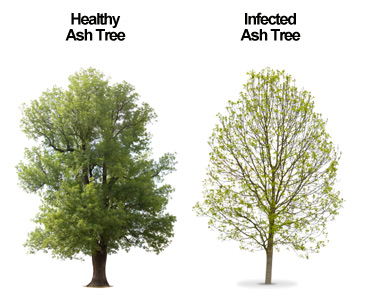Why EAB is a Serious Threat to All Ash Trees

The Emerald Ash Borer IS in St. Louis!!!! Sadly, like the American Elm or American Chestnut, the ash tree will effectively disappear from our landscape.
The Emerald Ash Borer (EAB) is a non-native insect from Asia that is killing every species of ash tree. This small, iridescent green insect lays its eggs inside the tree. Once hatched, the larva feed just under the bark disrupting the flow of water and nutrients through the tree.
Many communities have large populations of ash trees. After Dutch Elm Disease killed most of the American Elms in the early to mid 1900’s, ash trees, well adapted for the urban environment, were planted to fill the void. Now, EAB is devastating some forest communities costing billions of dollars.
First discovered in Michigan, this insect has made a slow march outward. Like many other invasive pests, humans have helped this pest move around. EAB can only travel a few miles each year on its own. Humans, however, have allowed this pest to travel hundreds of miles at a time. Infested trees are sometimes cut as firewood and then transported to new places where the beetles inside emerge to infest new trees. You can help slow the spread of EAB by not moving firewood. When camping, only buy firewood local to that area and leave any unused firewood at the camp.
Sadly, like the American Elm or American Chestnut, the ash tree will effectively disappear from our landscape.
What can you do? First, determine whether you have any ash trees on your property. You can tell an ash tree by the opposite branching, compound leaves, and brown twigs. If you have an ash tree you want to save, start now. The beetle may not be here but it is close, and this is one thing you do not want to be the first one on the block with. Bunton & Meyer Tree Service St. Louis offers preventative insecticide services that will help protect your trees from the invasion. Although mild infestations can be controlled, prevention is far better for the tree’s long term health.
One of our professional arborists can also help you determine which trees are worth protecting. Chemical control methods are not suitable for all trees. Call us and we can formulate a plan that keeps the integrity and beauty of your landscape while staying in a reasonable budget.
The Not- So-Bad Aftermath: Some areas where there are lots of ash trees may lose most of their trees; but we can plant more trees. Our urban forest contains many different types of trees, and this borer does not attack other trees. Areas with a good diversity of trees may not see much change at all. Genetic variability and human control efforts will allow a few ash trees to survive. With sound management and good planning our urban forests will survive. Environmental professionals battle exotic pests every day; we have the tools to combat this pest and reduce its impact. With community support and the help of professionals, our urban forests will be more diverse and stronger, just minus a few ash trees.
For more information: Call Bunton & Meyer Tree Service 314-426-2911
Or visit: http://extension.missouri.edu/emeraldashborer/about.aspx
